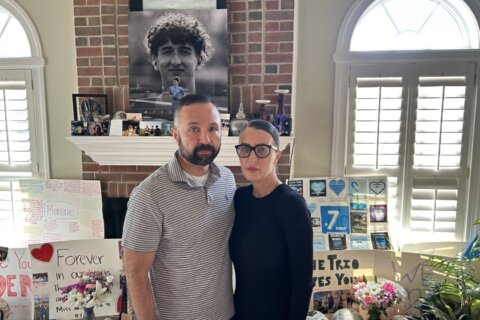This article was republished with permission from WTOP’s news partner InsideNoVa.com. Sign up for InsideNoVa.com’s free email subscription today.
This article was written by WTOP’s news partner InsideNoVa.com and republished with permission. Sign up for InsideNoVa.com’s free email subscription today.
A monument and historical marker noting the death of a Confederate officer, plus two Dahlgren naval howitzer cannons also on display outside the Fairfax County Judicial Complex will be removed and given to other organizations, the Board of Supervisors decided Oct. 20.
A majority of supervisors said the granite obelisk and historical marker, which commemorate the death of Confederate Capt. John Quincy Marr in a skirmish near the old Fairfax Courthouse on June 1, 1861, did not belong there.
“Monuments are declarations of our values and I’m proud to support the removal and relocation of the John Quincy Marr statue from the Fairfax County Courthouse,” Palchik said. “This monument does not reflect the values of our richly diverse community. In the spirit of our One Fairfax policy, a monument should serve as a testament to the declaration that all residents deserve an equitable opportunity to succeed.”
Palchik continued, “In addition, it is important to tell a more complete story of Fairfax County and recognize the voices that have been excluded from our history books.”
Officials now will move the Marr monument to a county storage facility at a cost of $19,562 and transfer possession and title of the obelisk to the non-profit Stuart-Mosby Historical Society.
Don Hakenson, an author and the society’s past president, said the group does not know yet how the transfer process will occur, but said the organization plans to install the monument on the grounds of the Stuart-Mosby Civil War Cavalry Museum in Centreville.
The group desired the monument because it was more than a century old and commemorated the first land engagement between Union and Confederate force, which occurred on the courthouse’s grounds, Hakenson said.
The cannons, donated in February 1910 by the U.S. Army, were popular among groups that filed requests with the county, Palchik said. The artillery’s new home will be the National Park Service’s Manassas National Battlefield Park.
The metal historical marker, No. 262, was installed near the Judicial Complex’s flagpole area in 2009 by the Virginia Department of Historical Resources and will be returned to that agency.
Supervisors on Sept. 15 voted to remove the Marr monument, painted-metal marker and brass cannons from the Judicial Complex, but gave museums, historical societies, military battlefields and other governments 30 days to express interest in relocating the artifacts. Several organizations responded and an evaluation team made up of county staff and two members of the Fairfax County History Commission reviewed the proposals Oct. 13, Palchik said.
The team considered the organizations’ missions, whether they were accredited museums, the final proposed locations for the objects, whether the artifacts would be stored or displayed, whether and how the objects would be interpreted, and whether the groups would be able to preserve and maintain the items in perpetuity, she said.
Supervisors on Oct. 20 defended their positions regarding Confederate monuments. Supervisor Patrick Herrity (R-Springfield), who voted against two of the three motions and was away from the dais for the third, said he did not support the monument’s removal, but was happy it would remain in the county.
Supervisor James Walkinshaw (D-Braddock) opposed what he said were efforts by Herrity and a local General Assembly member to redefine the Marr obelisk as a marker instead of a monument. The obelisk has been called a monument since its installation in June 1904 and has been similarly designated in various historical archives, he said.
“There’s an honest intellectual debate to be had about the decision that we’ve made, but it is not intellectually honest to say that the John Marr monument is a marker, not a monument.”
Historical records show 262 African-American residents voted at that courthouse during Reconstruction in 1867, but in 1902, under Virginia’s new constitution, black residents’ voting rights were denied via a poll tax and literacy test, Walkinshaw said.
“Hurdles were put in front of their opportunity to vote and people got together and said, ‘Let’s have one more hurdle,’” he said. “‘If you’re black in Fairfax County and you have the audacity to think you can still vote, if you want to pay the poll tax, if you think you can pass the absurd literacy test, you’re going to have to walk past a monument to a man who fought to keep you in chains.’”
Removing the monument does not amount to erasing history, but rather brings to light the rich history that occurred at that courthouse and had been erased, Walkinshaw said.
The historical marker identifies Marr as the first Confederate officer killed in action during the war. Some historians contend he was the first soldier on either side to die, but Supervisor John Foust (D-Dranesville) disputed that.
“It turns out Marr was not the first soldier killed in action,” Foust said. “They’re ignoring the suffering, death and dying of the Union soldiers [and] honoring a traitor who fought to preserve slavery . . . I really want to see it go. It’s not accurate.”
Blake Myers, preservation chairman for the Bull Run Civil War Round Table, dismissed Foust’s remarks as “simply not historically accurate and not true.”
While there may have been soldiers killed in isolated actions earlier in the nascent war, Marr was the only soldier to die in the Fairfax skirmish, which was the first land combat between organized military units, Myers said.
The state historical marker’s text is inaccurate, Myers added. Marr was not a Confederate soldier because his Virginia militia unit, the Warrenton Rifles, was not incorporated into the Confederate Army until nine days after the skirmish.
County officials currently are inventorying other Confederacy-related artifacts and will have discussions with the public and History Commission regarding their disposition, said Board of Supervisors Chairman Jeff McKay (D).
“I think what this action proves is that there are ways we can do this that don’t erase our history, but emphasize parts of our history that haven’t been heard already and properly contextualize things,” he said, adding he objected to the Marr monument’s location at the county’s Judicial Complex.
“This is our house of justice,” McKay said. “This is where people go to get a fair trial and the symbols that are on that property matter . . . These were not subtle images. These were put there for a reason.”







